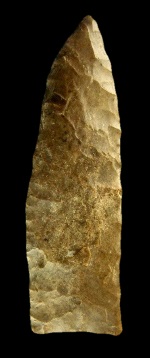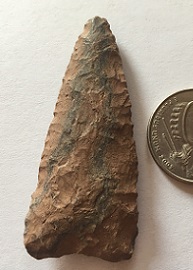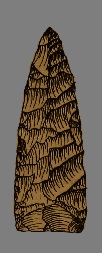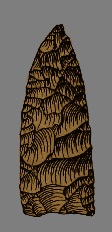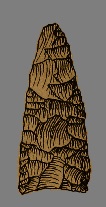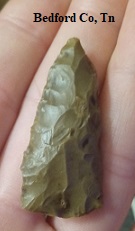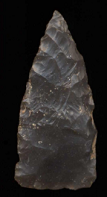Outline is Representative of Size and Shape:

Name Details:
Identified By: Madeline Kneberg
Named For: Type Site
Date Identified: 1956
Type Site: Frazier Site, Benton County, Tennessee
Identified By: Madeline Kneberg
Named For: Type Site
Date Identified: 1956
Type Site: Frazier Site, Benton County, Tennessee
Point Validity:
Valid type
Kneberg was a prominent anthropologist and professor at the University of Tennessee. She is most recognized for her excavations through-out the Tennessee River Valley. This type was named in a professional publication and has many professional references. This is considered a valid type.
Kneberg was a prominent anthropologist and professor at the University of Tennessee. She is most recognized for her excavations through-out the Tennessee River Valley. This type was named in a professional publication and has many professional references. This is considered a valid type.
Frazier Lanceolate
Cluster: Description of Physical Characteristics and Flaking Pattern:
This is thin medium (2 to 2.75 inches) lanceolate point with a flattened cross section. The blade is excurvate, curving in at the tip and having almost parallel edges. The blade commonly has fine serrations due to re-sharpening techniques. The base is primarily slightly concave, but may vary to straight. Basal thinning is present on this point. This point is made using primary percussion flaking and fin pressure flaking on all edges forming a random flaking pattern.
Size Measurements:
Total Length - 45 to 51 mm (49 mm average), Width -21 to 25 mm (23 mm average), Thickness - 6 to 8 mm
Total Length - 45 to 51 mm (49 mm average), Width -21 to 25 mm (23 mm average), Thickness - 6 to 8 mm
Commonly Utilized Material:
Additional Comments:
There is differing ideas on the date of this point. Kneberg (1956) places this point between 1,500 B.C. to about 100 A.D. placing this point as a Late Archaic to Early Woodland point. Cambron (1975) feels that the dates may be incorrect and places this point as an Early Archaic type point with dates based around 6,000 - 4,000 B.C. based on surface collections of Early Archaic sites and associations with Early Archaic type points. In support of Kneberg's assessment, these points rarely have any hafting region grinding which is commonly seen in Early Archaic type points.
This point is narrower with a flatter base and higher quality flaking than the similar Paint Rock Valley point (Cambron, 1969).
There is differing ideas on the date of this point. Kneberg (1956) places this point between 1,500 B.C. to about 100 A.D. placing this point as a Late Archaic to Early Woodland point. Cambron (1975) feels that the dates may be incorrect and places this point as an Early Archaic type point with dates based around 6,000 - 4,000 B.C. based on surface collections of Early Archaic sites and associations with Early Archaic type points. In support of Kneberg's assessment, these points rarely have any hafting region grinding which is commonly seen in Early Archaic type points.
This point is narrower with a flatter base and higher quality flaking than the similar Paint Rock Valley point (Cambron, 1969).
Distribution: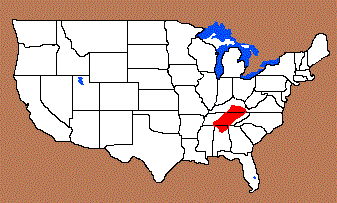
Distribution Comments:
This point is primarily found in the Tennessee River Valley of southeastern Kentucky and Tennessee. Cambron reports that this point is rare in Alabama.
This point is primarily found in the Tennessee River Valley of southeastern Kentucky and Tennessee. Cambron reports that this point is rare in Alabama.
Age / Periods:
Date: 3,500 - 1,800 B.P. (see comments)
Cultural Period: Middle to Late Archaic
Glacial Period: Neoglacial to Roman Warm
Culture:
Date: 3,500 - 1,800 B.P. (see comments)
Cultural Period: Middle to Late Archaic
Glacial Period: Neoglacial to Roman Warm
Culture:
Age Details:
Other points in this cluster / Related / Associated Points:

